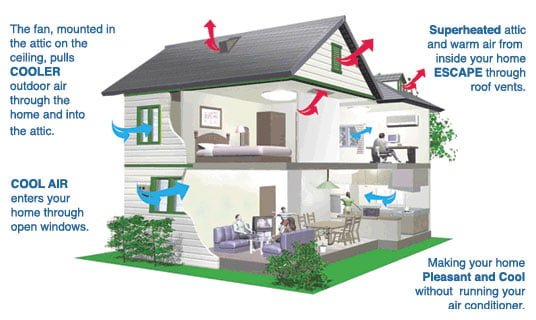Whole house fans cool homes very efficiently in most areas of the country. But old whole house fans have come under fire for creating leaks into the attic, causing potential depressurization problems and being very noisy.

It doesn’t make much sense to use an air conditioner to cool your home when the outside air is cooler than inside. So in areas with hot days and cool nights, people often use whole house attic fans to exhaust hot indoor air once the outside temperature drops below about 70°F. Whole house cooling fans operate during the evening or at night during hot summer days to cool the house. Whole house fans should not be confused with low-velocity attic ventilation fans, which only removes hot air from the attic and do nothing to cool the living space.
New whole house fans are installed in the ceiling, in an opening that is cut into the attic. They exhaust indoor air out through attic vents, replacing it with cool, fresh outside air drawn in through open windows. Residents turn on the fan and open windows when the outside temperature drops below the inside temperature, and for best results, they leave the fan on for several hours–preferably overnight. This cools the house down and also flushes built-up heat (much of which would otherwise find its way back into the home) out of the attic.
In some climates–those with wide swings between day and nighttime temperatures, such as drier, inland sites–whole house fans can replace air conditioning altogether. In others, they can reduce the run time of the air conditioner and precool the home so the air conditioner doesn’t have to work as hard. Residents with air conditioning are often able to use a whole house fan exclusively in spring and fall, and during much of the summer, turning on the air conditioner only on extremely hot or humid days.
Whole house fans are not well suited to very humid climates because they bring in moisture with the air. On the other hand, many people prefer to use outdoor air for cooling, because they find that the air conditioner dries the air out too much, or because they enjoy the gentle breeze a fan can create.
But how big should a whole house fan be? Traditional whole house fan sizing methods are based on getting enough air flowing through the home to create a cooling breeze while providing 15-20 air changes per hour (ACH) and flushing heat out of the attic. A gentle breeze causes evaporation off the human body and therefore can make the temperature feel several degrees cooler than it actually is. However, whole house fans that are big enough to create a breeze sometimes produce unintended effects, such as heat loss, noise, and house depressurization.
Whole House Exhaust Fan and the House System
Old whole house fans can use up to 1000 watts and can move between 3500 and 7500 cubic feet per minute (CFM) of air, depending on the size of the home. Although this presents quite a range of possible fan sizes for a given house, it is vital that the house system is set up to handle it without causing harmful side effects from depressurization. This includes having enough attic vents for the air to escape through and having enough open window area to replace the air being exhausted.
Attic Vents
To make sure the air drawn up into the attic can escape, there must be about 1 foot of net free area for every 750 CFM of fan airflow. For instance, to install a 3000 CFM fan, a homeowner should make sure there are at least 4 square feet of net free vent area in the attic. Standard building codes typically require a minimum of 1 foot of net free vent area in the attic for every 300 feet of attic floor area. For example, a 1,500 feet one-story home would probably have about 5 feet of net free vent area already installed to meet the minimum code.
What happens if there is not enough vent area in the attic? First, the fan cannot move as much air, because the lack of an escape route causes backpressure on it from the attic air. The fan cannot work well, even though it may look and feel as if it does. Second, the pressurized (and possibly quite hot) attic air will find its way back into the house through leaks in the attic floor, walls, and ceiling. And finally, the backpressure on the fan will cause a whistling noise at the fan.
Open Windows
Residents need to remember to open windows while the whole-house fan is running. Without sufficient open-window area, the fan motor has to work too hard to pull air through the smaller openings within the structure, and this may cause the fan motor to burn out prematurely. Even worse, a fan desperate for air may backdraft a gas water heater, fireplace, furnace or clothes dryer.
For air to flow freely through the house without causing depressurization, the total open-window area should be approximately the same as the attic’s net free vent area through which the air is escaping. So for the 3000 CFM fan discussed above, there should be about 4 sqft of total open window area. However, if there are screens on the windows, this number should be multiplied by three to account for the extra resistance. That would be 12 sqft of open, screened windows. For vertical sliding windows 2.5 feet wide, for example, opening two windows to a height of about 2.5 feet could accomplish this. However, a little depressurization of the home helps to create the breeze effect, and many people use somewhat less open window area despite the problems it may cause.
With the older noisier whole house fans, people who chose to close the windows and turn off the fan when they go to sleep are cutting short the fan’s running time. As a result, heat that remains stored in the walls, floors, and ceilings is then slowly released into the home throughout the night and is not flushed out causing the home to stay warm.
Insulation and Air Sealing
Whole house fans are installed in a hole in the ceiling leading into the attic. This can create an uninsulated area of the attic, up to 9 square feet for a 36-inch whole house fan like you’d typically find at one of those big box stores. These older style fans generally have louvers that close when they’re turned off, but these louvers are not usually airtight. Energy specialists often recommend that homeowners consider a modern and quiet whole house fans like those from Centric Air that they have a cold weather dampers.
Whole House Fan Noise
The old style whole house fans use inexpensive, industrial motors that tend to be very noisy. This can cause residents to use them sporadically, turning them off whenever the noise bothers them. In addition, many older style fans are belt drive and require maintenance every couple of years. These old style whole house fans also require extensive framing in the attic when installing. An improper installation can also cause the unit to vibrate and make excessive noise. And a fan trying to force air out through vents that are too small will emit an annoying whistle. In general, the cheapest fans versus the higher-quality fans are the noisiest. Those considering a whole house fan should consider, the modern and ultra quiet whole house fans made by CentricAir. These newer style of whole house fans are maintenance free and do not require any custom framing when installing.
The Whole-House Approach
Should whole house fans be included on a modern energy efficiency retrofit list? Yes, they should. In many cases, they provide efficient and effective cooling. And they are very cost effective to operate — most modern and ultra quiet whole house fans, like those from Centric Air, only cost about $0.02 to $0.04 cents per hour to run.
Whole house fans have been around for over 50 years, but thanks to recent advances in technology, the new style of ultra quiet whole house fans are more efficient, better insulated and require no framing when installing. View CentricAir whole house fan installation pictures, or view the whole house fan installation video.
